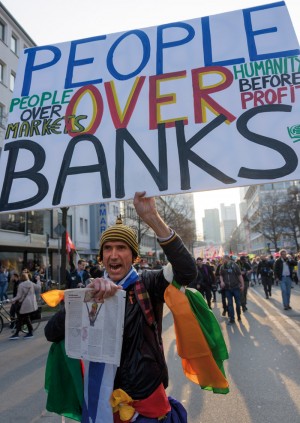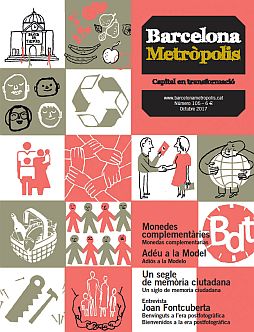
Financial intermediaries have got stronger and stronger as a result of the digital revolution, unlike what has happened in most economic sectors. In the image, demonstration against European Union policies for Greece during the inauguration of the new headquarters of the European Central Bank in Frankfurt in March 2015.
Photo: Horacio Villalobos / Corbis / Getty Images
The digital revolution has eliminated intermediaries from most economic sectors, apart from the area of finance where they have strengthened their grip. The ability to create currency — the exclusive domain of banks — is the primary reason for this anomaly. The solution is to develop new currency-creation mechanisms.
If we had to summarise what effect digitisation was having on the financial sector, it would probably go something like this: to facilitate buying and selling and increase speculation. This has triggered the emergence of speculative bubbles and accelerated economic cycles, with the effect that financial crises have become more frequent. And with each financial crisis, the banking sector becomes more concentrated and the power of those entities still standing only increases.
European Union regulators have perceived the danger in depending on these increasingly large entities, who own practically all the digital payments, thus making them “too big to fail”. Every crisis causes ever greater concentration in the sector and increases the vulnerability to which society is exposed. It is true that the emerging mega banks are the main owners of these payment systems, but they are also the principal creators of currency. No matter how many alternatives to the banking sector become regulated, they all work with the money of the banks: the new payment system providers have bank accounts for carrying out their payment services and have to use the compensation systems belonging to the financial system. Regulated in 2015, the new for-profit crowdfunding platforms also work with bank money, generally through certified payment system providers. Even the new electronic money providers are obliged to have bank money in the same amounts as they emit in electronic money so as to provide their customers with the option of exchanging it for bank funds or cash. In short, regulated currency creation remains exclusively in the hands of the banking sector, although the number of regulators who think it necessary to create alternative options is increasing, little by little. The Bank of England, for example, is the first to have shown a clear interest in fostering the emergence of alternative forms of monetary creation.
The social element in the drive for innovation
One of the core characteristics of the existing financial and monetary system is its profoundly hierarchical public-private structure: states and central banks sit at the top, next come the large private and commercial banks followed by the small banks and, lastly, the non-banking sector. This power structure is fundamentally incompatible with a democratic system; in fact, a large part of the monetary system dates from pre-democratic times. In any case, this hierarchy is of a social and political nature.

Faced with the present profoundly hierarchical monetary and financial system, which is actually incompatible with a democratic society, alternatives are being considered that have a strong community element, such as business exchange systems with participatory management. In the image, the offices of Coop57, a services cooperative providing an alternative form of finance and saving for organisations and individuals.
Photo: Dani Codina
Given this information about the financial system, two diametrically opposed alternatives are available:
– Eliminate the social component. Some systems try to function without the need for the parties involved to talk to each other, that is, eschewing the need for a social structure for them to work. Examples include Bitcoin and several other types of currency based on blockchain technologies, in particular those whose total units of currency are predefined. These currencies are generated in a decentralised, but not necessarily democratic or egalitarian manner, using technology that enables the creation of a perfect mechanism for maintaining currency value, impervious to the actions of governments or other parties capable of intervening in that regard, except in the supply and demand of currency.
– Enhance the social component. On the other hand, some currencies exist because their promoters are interested in doing quite the opposite: democratising the monetary creation process. This type includes social currencies and business exchange systems, which are often managed in a participatory and civic manner. In this case, money plays an instrumental role and the objective is to create a financial tool that enables an economic system to evolve in accordance with publicly defined priorities, with specific goals such as providing liquidity to the real economy, creating a more equitable economic system and promoting environmental sustainability.
The evolution of trust
The cornerstone of currency is trust, which has evolved in radically different ways compared to the conventional monetary and financial system in both of the above currency groups. For currencies based on the first type, trust is based on the technology used, on the incorruptible nature of their coding and encryption. In the second example, trust is founded on the interpersonal (P2P) and community relationships of the persons involved. There are also social currency projects that try to combine both sources of trust.
Complementary currencies often emerge after a financial crisis. These crises frequently produce monetary contractions, which a social currency system based on mutual credit can complement with additional liquidity. Often, these currency experiments are dismantled as soon as the emergency is over (as happened with most of the barter clubs in Argentina), but some have survived: the Swiss WIR, for example, has been around for more than 80 years.
The potential for new currencies to prosper would be fully justified given the evolution of the financial system, which could lead to unforeseen scenarios in which the social function of banks becomes even more compromised than it is now. There are a number of conditions that would strengthen this potential. First of all, there would be a need for these currencies to remain unregulated until such time as their capacities were fully developed, and for city councils and other public agencies to support their implementation — while not forgetting that they must be managed by the public. Second, there should be a drive for innovation in trust systems, for example, in systems that enable trust between citizens to be recorded. Third, information should be disseminated about how the current monetary system and the complementary currencies work. Lastly, different currency systems and payment compensation mechanisms should be promoted, so that the interoperability of complementary currencies does not rely on the conventional methods used by the banks.
Disintermediation in currency creation could have huge benefits for the general public if innovation is directed at achieving them.



